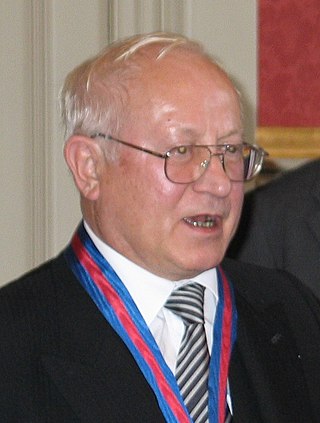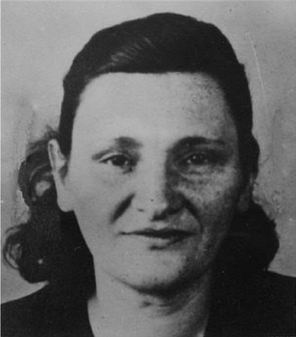The Venona project was a United States counterintelligence program initiated during World War II by the United States Army's Signal Intelligence Service and later absorbed by the National Security Agency (NSA), that ran from February 1, 1943, until October 1, 1980. It was intended to decrypt messages transmitted by the intelligence agencies of the Soviet Union. Initiated when the Soviet Union was an ally of the US, the program continued during the Cold War, when the Soviet Union was considered an enemy.

Oleg Antonovich Gordievsky, CMG is a former colonel of the KGB who became KGB resident-designate (rezident) and bureau chief in London.
Kitty Harris was a Canadian-born Soviet secret agent and "long-time special courier of the OGPU-NKVD foreign intelligence during the 1930s and 1940s." Although mentioned by name in Walter Krivitsky’s book I was Stalin’s agent, Harris was identified only in 2001 when her code name "Ada" or "Aida" was found in declassified files from the Venona project. This was a counterintelligence program initiated by the United States Army's Signal Intelligence Service that ran from February 1, 1943 until October 1, 1980.

Jack Soble was a Lithuanian who, together with his brother Robert Soblen, penetrated Leon Trotsky's entourage for Soviet intelligence in the 1920s. Later, in the United States, he was jailed, with his wife Myra, on espionage charges. He was born in Vilkaviskis, Lithuania as Abromas Sobolevicius and sometimes used the name Abraham Sobolevicius or Adolph Senin.

Elizabeth Terrill Bentley was an American NKVD spymaster, who was recruited from within the Communist Party USA (CPUSA). She served the Soviet Union as the primary handler of multiple highly placed moles within both the United States Federal Government and the Office of Strategic Services from 1938 to 1945. She defected by contacting the Federal Bureau of Investigation (FBI) and debriefing about her espionage activities.
As early as the 1920s, the Soviet Union, through its GRU, OGPU, NKVD, and KGB intelligence agencies, used Russian and foreign-born nationals, as well as Communists of American origin, to perform espionage activities in the United States, forming various spy rings. Particularly during the 1940s, some of these espionage networks had contact with various U.S. government agencies. These Soviet espionage networks illegally transmitted confidential information to Moscow, such as information on the development of the atomic bomb. Soviet spies also participated in propaganda and disinformation operations, known as active measures, and attempted to sabotage diplomatic relationships between the U.S. and its allies.

Iskhak Abdulovich Akhmerov (1901–1976) was a highly decorated OGPU/NKVD (KGB) Soviet security officer, best known to historians for his role in KGB operations in the United States 1942–1945. His name appears in the Venona decryptions over fifty times, often as signatory, and on his return to the Soviet Union in 1945/46, he rose to deputy chief of the KGB's 'illegal' intelligence section.
Francia Yakovlevna Mitinen, originally Frances Metianen, and also known, erroneously, as "Francia Yakilnilna Mitynen" was an Australian-born Soviet "illegal" spy for Soviet military intelligence (GRU) in the United States during the 1940s and 1950s. The main alias used by Mitinen in the US was Edna Margaret Patterson. Her codenames, in Soviet intelligence circles included "Салли" "Sally", and "Австралийка" "Avstraliyka", which is the feminine form of "(The) Australian". US counterintelligence services, however, usually translated the latter name as "The Australian Woman".

Arvid Werner Jacobson was a Finnish-American communist who spied for the Soviet Union in the 1930s.
Alfred Tilton or Alfred Matisovich Tyltyn was the head of Soviet Military Intelligence (GRU) in the United States in the late 1920s. He is best remembered for having recruited Latvian-American communist Nicholas Dozenberg to work for the GRU late in 1927.
Anatoly Veniaminovich Gorsky, was a Soviet spy who, under cover as First Secretary "Anatoly Borisovich Gromov" of the Soviet Embassy in Washington, was secretly rezident in the United States at the end of World War II.
Elza Akhmerova, also Elsa Akhmerova, was an American citizen, born Helen Lowry. She was a distant relative of Earl Browder, General Secretary of the Communist Party of the United States (CPUSA). She died of leukemia.

Alexander Ulanovsky (1891–1970) was the chief illegal "rezident" for Soviet Military Intelligence (GRU), who was rezident in the United States 1931–1932 with his wife and was imprisoned in the 1950s with his family in the Soviet gulag.
The OMS, also known in English as the International Liaison Department (1921–1939), was "the most secret department" of the Executive Committee of the Communist International. It has also been translated as the Illegal Liaison Section and Foreign Liaison Department.
Isaiah Oggins was an American-born communist and spy for the Soviet secret police. After working in Europe and the Far East, Oggins was arrested, served eight years in the GULAG detention system, and was summarily executed on the orders of Joseph Stalin.
Vasily Mikhailovich Zarubin was a Soviet intelligence officer. In the United States, he used the cover name Vasily Zubilin and served as the chief Soviet intelligence Rezident from 1941 to 1944. Zarubin's wife, Elizaveta, served with him.
Robert Gordon Switz was a "wealthy American who converted to communism" and served as spy for Soviet Military Intelligence ("GRU").

Malvina Gruber, née Hofstadterova was a Jewish Comintern agent, who was part of a Soviet intelligence network in Belgium and France, that was later called the Red Orchestra by the Abwehr, during Nazi regime. Gruber worked as a cutout, but her specialism was couriering people across borders. From 1938 to 1942, Gruber worked as assistant to Soviet agent Abraham Rajchmann, a forger, who provided identity papers, e.g. the Kennkarte, Carte d'identité and travel permits, for the espionage group. At the beginning of 1942, she was arrested in Brussels by the Abwehr.
Germaine Schneider was a Belgian communist and Communist International (Comintern) agent. During the latter half of the 1920s, Schneider worked predominantly for the Communist Party of Belgium. During the interwar period and early World War II, Schneider was a core member of a Soviet espionage group. She worked as a principal courier for the groups that were associated with the Comintern agent, Henry Robinson in the late 1930s in France and later the Soviet GRU officer, Konstantin Jeffremov in Belgium and the Low Countries, in the early 1940s. These groups were later identified by the Abwehr under the moniker the Red Orchestra. Schneider used the aliases Clais, Pauline, Odette, Papillon and Butterfly (Schmetterling) to disguise her identity.







